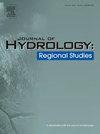A novel hybrid machine learning framework for spatio-temporal analysis of reference evapotranspiration in India
IF 4.7
2区 地球科学
Q1 WATER RESOURCES
引用次数: 0
Abstract
Study region
The study focuses on the diverse climatic regions of India, spanning arid, semi-arid, sub-humid, and humid zones.
Study focus
This research employs a novel hybrid machine learning (ML) framework for precise spatio-temporal reference evapotranspiration (ETo) modelling from 1970 to 2024, addressing the variability in temperature, humidity, and precipitation. Three advanced ML models—Quantile-Adjusted xLSTM Network (QAxLNet), Quantile-Score Diffusion Model (QSDM), and Attentive Deep Quantile-Aware Autoencoder Network (ADAQNet)—are proposed and applied, focusing on relative humidity and temperature as critical predictors. Model validation, conducted with EEFlux-derived ETo data and Indian Meteorological Department (IMD) benchmarks, revealed strong alignment across diverse climatic zones.
New hydrological insights for the region
The MPI-ESM1–2-HR model under SSP3–7.0 scenarios outperformed other CMIP6 models, with a correlation coefficient of 0.975 and spatial error of 3.55 mm. The ADAQNet demonstrated superior performance, with lowest errors RMSE (Train: 0.2247, Test: 0.2499), and R2 (Train: 0.96; Test: 0.9571) among the models. ETo declined at an average rate of 1.9 mm/year, indicating the role of climate change. ETo variability closely mirrored the spatial distribution of the National Building Code (NBC) of India. Seasonal variations were significant, with arid regions (Rajasthan, Gujarat) experiencing the highest increase (2.5–5.1 mm/year). Humid regions showed high sensitivity to RH forecasts, with up to 20 % ETo deviation. The study emphasizes the spatial, temporal, and seasonal variations of ETo across the region, highlighting its dependence on climatic factors.
求助全文
约1分钟内获得全文
求助全文
来源期刊

Journal of Hydrology-Regional Studies
Earth and Planetary Sciences-Earth and Planetary Sciences (miscellaneous)
CiteScore
6.70
自引率
8.50%
发文量
284
审稿时长
60 days
期刊介绍:
Journal of Hydrology: Regional Studies publishes original research papers enhancing the science of hydrology and aiming at region-specific problems, past and future conditions, analysis, review and solutions. The journal particularly welcomes research papers that deliver new insights into region-specific hydrological processes and responses to changing conditions, as well as contributions that incorporate interdisciplinarity and translational science.
 求助内容:
求助内容: 应助结果提醒方式:
应助结果提醒方式:


